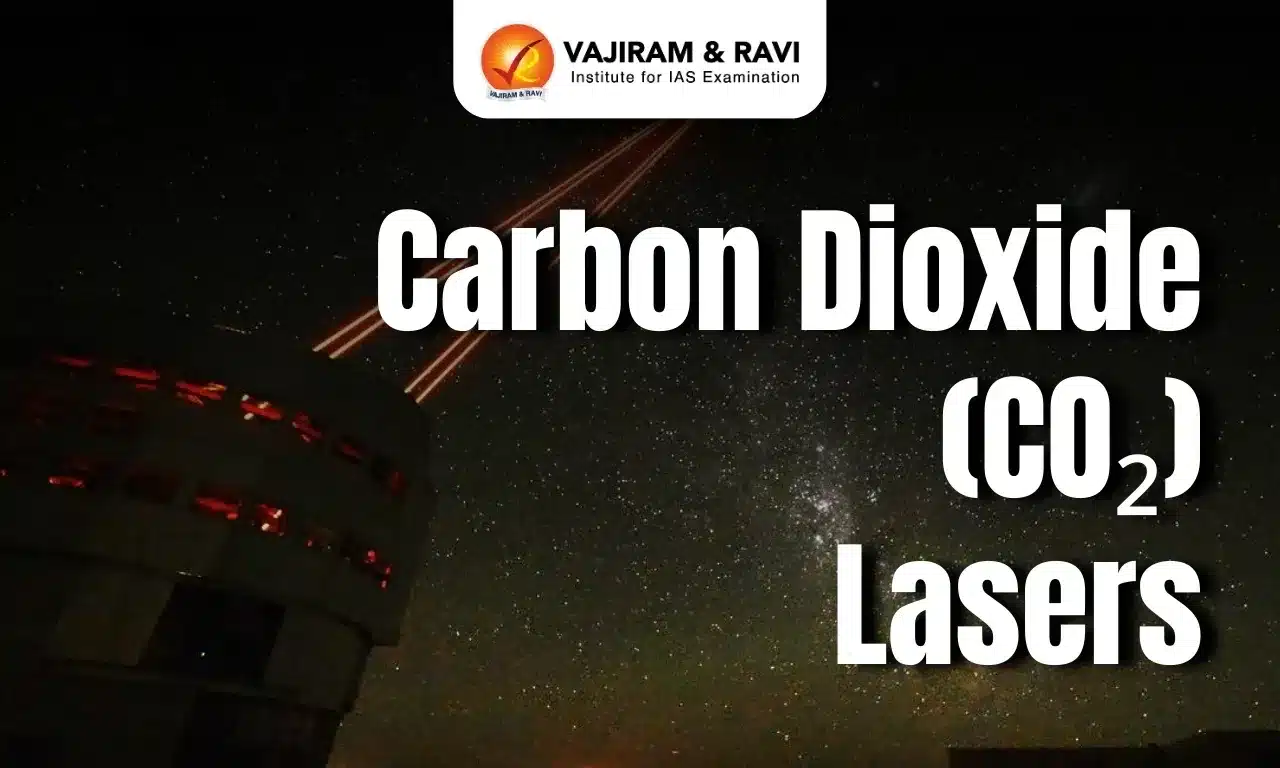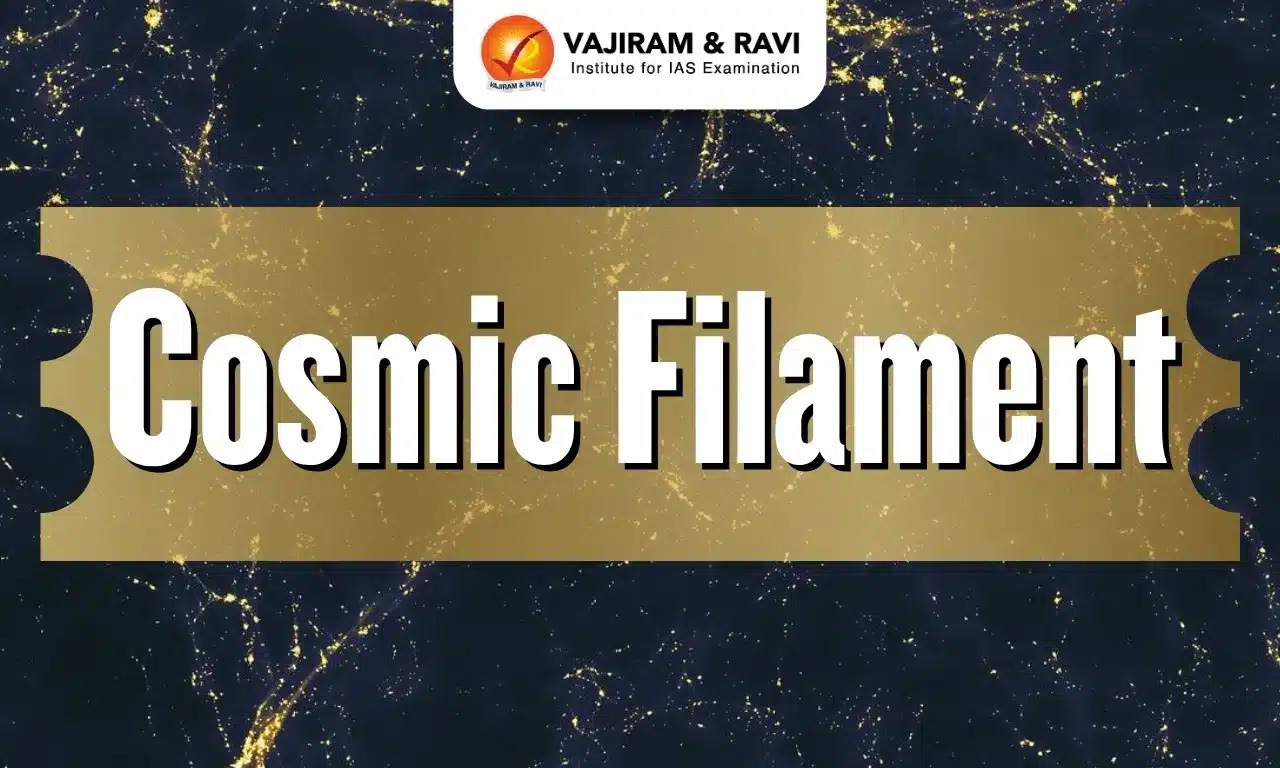Carbon dioxide (CO₂) Lasers Latest News
Physicists in the US have demonstrated a novel technique to detect radioactive materials remotely using carbon dioxide (CO₂) lasers.
About Carbon Dioxide (CO₂) Lasers
- The first CO₂ laser was developed by Indian-American scientist Prof. C.K.N. Patel.
- It is a four-level molecular gas laser that operates using vibrational energy states of CO₂ molecules.
- Highly efficient, producing high-power continuous or pulsed output.
- Structure: A CO₂ molecule consists of one carbon atom at the center and two oxygen atoms on either side. It vibrates in three independent modes:
- Symmetric Stretching Mode: Oxygen atoms move simultaneously towards or away from the fixed carbon atom.
- Bending Mode: Carbon and oxygen atoms vibrate perpendicular to the molecular axis.
- Asymmetric Stretching Mode: Oxygen atoms move in one direction, while the carbon atom moves in the opposite direction.
- Principle of CO₂ Laser: The laser transition occurs between vibrational energy states of CO₂ molecules. Energy is transferred from excited nitrogen (N₂) molecules to CO₂, achieving the population inversion necessary for laser action.
Characteristics of CO₂ Laser
- Type: Molecular gas, four-level laser.
- Active medium: Gas mixture of CO₂, N₂, and He.
- Pumping Method: Electrical discharge.
- Optical Resonator: Concave mirrors.
- Power Output: Up to 10 kW.
- Nature of Output: Continuous wave (CW) or pulsed wave.
- Wavelength: 9.6 μm & 10.6 μm (Infrared region).
How Does the Detection Work?
- Radioactive decay & ionisation: When a material undergoes radioactive decay, it emits charged particles (alpha, beta, or gamma rays) that ionize the surrounding air, creating plasma.
- Avalanche effect: The free electrons in plasma gain energy and collide with other atoms, releasing more electrons. This self-sustaining process is called avalanche breakdown and leads to a chain reaction of ionization.
- Laser characteristics: Researchers used a carbon-dioxide (CO₂) laser emitting long-wave infrared (LWIR) radiation at 9.2 micrometres. The longer wavelength reduces unwanted ionization and improves sensitivity.
- Detection mechanism: The laser accelerates seed electrons in the plasma, creating microplasma balls. These microplasmas generate a measurable optical backscatter that can be detected and analyzed.
- Fluorescence imaging: Used to analyze the plasma formation dynamics and understand the distribution of seed electrons.
- Mathematical model: Developed to predict backscatter signals based on plasma seed densities.
- Validation: The model accurately reproduced experimental results, confirming the reliability of the detection technique.
Advancements in Detection Range
|
Parameter |
Previous Techniques |
New CO₂ Laser Technique |
|
Alpha particle detection |
1 meter |
10 meters (10x improvement) |
|
Gamma ray detection (cs-137) |
Limited capability |
Up to 100 meters |
|
Potential future range |
~10 meters max |
Possibly 1 km+ with improvements |
- Alpha particles: Successfully detected from 10 meters away (10x improvement over previous methods).
- Gamma rays (Cs-137): Could potentially be detected from 100 meters away by scaling up laser optics.
Carbon dioxide (CO₂) Lasers FAQs
Q1: What is a Carbon Dioxide (CO₂) laser?
Ans: A CO₂ laser is a gas laser that uses a mixture of carbon dioxide, nitrogen, and helium to produce infrared light, widely used in industrial and medical applications.
Q2: What are the applications of CO₂ lasers?
Ans: CO₂ lasers are used in cutting, welding, engraving, and medical treatments such as laser surgery and skin resurfacing.
Q3: Why are CO₂ lasers preferred for industrial cutting?
Ans: CO₂ lasers have high power efficiency and precision, making them ideal for cutting and engraving metals, plastics, and other materials.
Q4: What is the wavelength of a CO₂ laser?
Ans: The wavelength of a CO₂ laser is around 10.6 micrometers (infrared range), which is ideal for heating and cutting applications.
Source: TH
Last updated on November, 2025
→ Check out the latest UPSC Syllabus 2026 here.
→ Join Vajiram & Ravi’s Interview Guidance Programme for expert help to crack your final UPSC stage.
→ UPSC Mains Result 2025 is now out.
→ UPSC Notification 2026 is scheduled to be released on January 14, 2026.
→ UPSC Calendar 2026 is released on 15th May, 2025.
→ The UPSC Vacancy 2025 were released 1129, out of which 979 were for UPSC CSE and remaining 150 are for UPSC IFoS.
→ UPSC Prelims 2026 will be conducted on 24th May, 2026 & UPSC Mains 2026 will be conducted on 21st August 2026.
→ The UPSC Selection Process is of 3 stages-Prelims, Mains and Interview.
→ UPSC Result 2024 is released with latest UPSC Marksheet 2024. Check Now!
→ UPSC Prelims Result 2025 is out now for the CSE held on 25 May 2025.
→ UPSC Toppers List 2024 is released now. Shakti Dubey is UPSC AIR 1 2024 Topper.
→ UPSC Prelims Question Paper 2025 and Unofficial Prelims Answer Key 2025 are available now.
→ UPSC Mains Question Paper 2025 is out for Essay, GS 1, 2, 3 & GS 4.
→ UPSC Mains Indian Language Question Paper 2025 is now out.
→ UPSC Mains Optional Question Paper 2025 is now out.
→ Also check Best IAS Coaching in Delhi

















